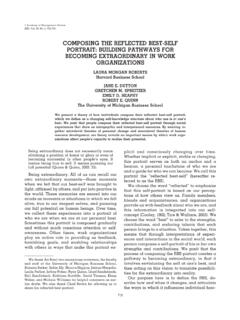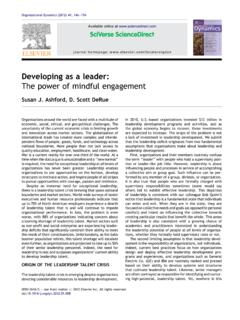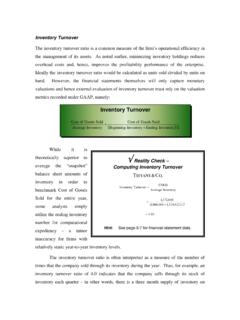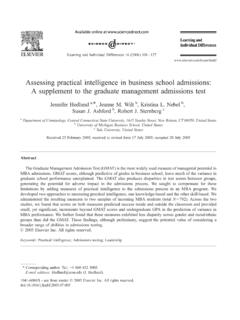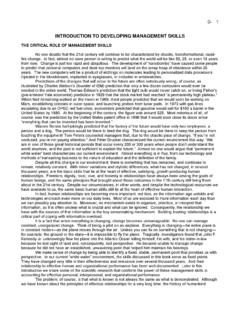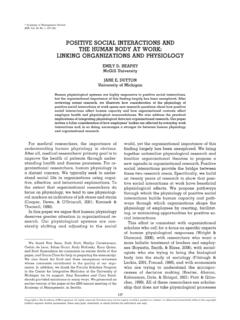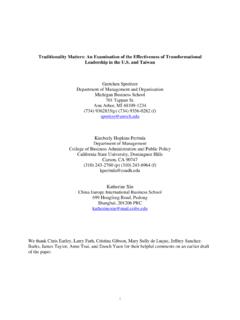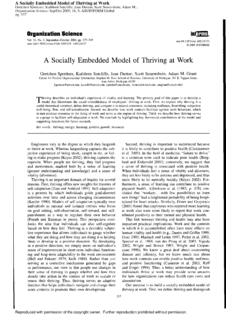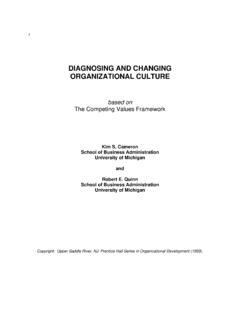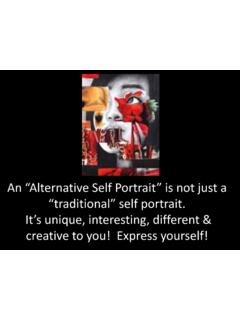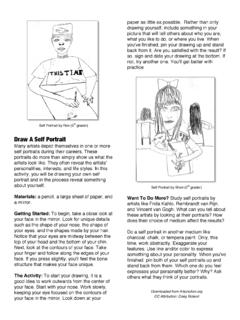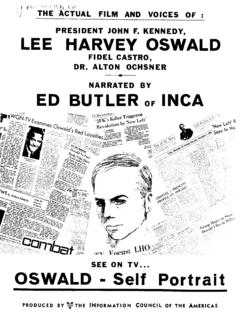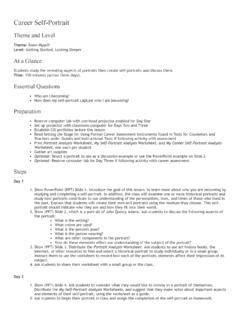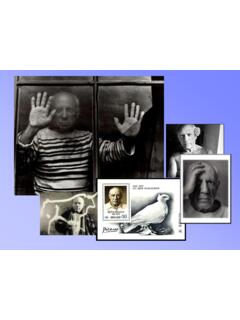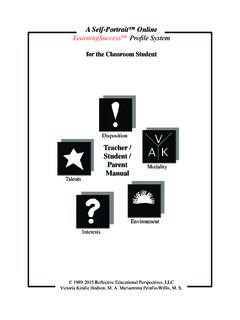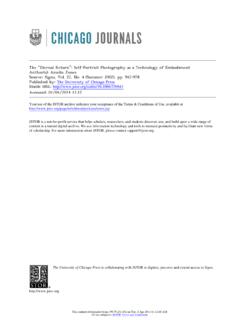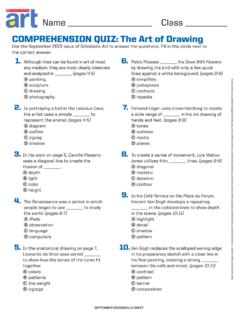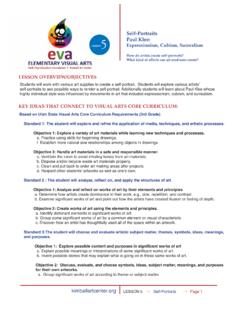Transcription of Composing the Reflected Best Self-Portrait
1 Composing the Reflected best - self portrait : Building Pathways for Becoming Extraordinary in Work Organizations Laura Morgan Roberts Harvard Business School Jane E. Dutton Gretchen Spreitzer Emily D. Heaphy and Robert E. Quinn The University of Michigan Business School Manuscript under review at the Academy of Management Review. Please do not cite or circulate without the authors permission. Please direct any correspondence to: Laura Morgan Roberts, Harvard Business School, Morgan Hall 317, Boston, MA 02163, (617) 496-9633, or Jane E. Dutton, University of Michigan Business School; 701 E. Tappan Street, Ann Arbor, MI 48109, (734) 764-1376, The authors wish to thank Art Brief, two anonymous reviewers, faculty and staff at the University of Michigan Business School, Brianna Barker, Robin Ely, Monica Higgins, Joshua Margolis, Leslie Perlow, Jeffrey Polzer, Ryan Quinn, Lloyd Sandelands, Neil Sendlebach, Kathleen Sutcliffe, David Thomas, Klaus Weber, and Michele Williams for helpful comments on earlier drafts.
2 We would also like to thank Chad Brown for allowing us to share his Reflected best portrait . Abstract This paper presents a theory of how individuals compose their Reflected best - self portraits, which we define as a changing self -knowledge structure about who one is at one s best . By weaving together micro-level theories of personal change and macro-level theories of human resource development, our theory reveals an important means by which work organizations affect people s capacity to realize their potential. We posit that people compose their Reflected best - self portraits through social experiences that draw upon intrapsychic and interpersonal resources. In particular, we propose that people periodically experience jolts that enable them to increase the clarity or change the content of their Reflected best - self portraits. Jolts, when accompanied by socially embedded resources such as positive affect, positive relationships and personal agency enable personal transformation by (1) expanding the constellation of possible selves, (2) enhancing personal expressiveness and (3) facilitating social architecting.
3 These changes, in turn, propel individuals along a pathway of becoming extraordinary. 2 Composing the Reflected best - self portrait : Building Pathways for Becoming Extraordinary in Work Organizations Being extraordinary does not necessarily mean obtaining a position of honor or glory or even of becoming successful in other people s eyes. It means being true to self . It means pursuing our full potential. -- Quinn & Quinn, 2002, p. 35 Being extraordinary. All of us can recall our own extraordinary moments, those moments when we felt that our best - self was brought to light, affirmed by others and put into practice in the world. These memories are seared into our minds as moments or situations in which we have felt alive, true to our deepest selves and pursuing our full potential as human beings. Over time, we collect these experiences into a portrait of whom we are when we are at our personal best . Sometimes this portrait is composed gradually and without much conscious attention or self -awareness.
4 Other times, work organizations play an active role in providing us feedback, furnishing goals, and enabling relationships with others in ways that make this portrait explicit and consciously changing over time. Whether implicit or explicit, stable or changing, this portrait serves as both an anchor and a beacon, a personal touchstone of who we are and a guide for who we can become. We call this portrait the Reflected best - self . We choose the word Reflected to emphasize that this Self-Portrait is based on our perceptions of how others view us. Family members, friends and acquaintances, and organizations provide us with feedback about who we are, and this information is integrated into our self -concept (Cooley, 1902; Tice & Wallace, 2003). We choose the word best to refer to the strengths, contributions, and enduring talents that each person brings to a situation. Taken together, this means that through interpretations of experiences and interactions in the social world, each person composes a Self-Portrait of his or her own strengths and contributions.
5 We posit that the process of Composing the Reflected best - self portrait creates a pathway to becoming 3extraordinary, in that it involves envisioning the self at one s best , and then acting upon this vision to translate possibilities for the extraordinary into reality. The purpose of this paper is to define the Reflected best - self , describe how and when it changes, and articulate the ways in which it influences individual functioning in organizations. By providing a theoretical account of the situational and social mechanisms through which people compose their Reflected best - self portraits, we shed new light on how organizations can enable people to develop to their full potential. In so doing, we build upon the principles of positive psychology (Seligman & Csikszentmihalyi, 2000) and positive organizational scholarship (Cameron, Dutton & Quinn, 2003; Luthans, 2002), which aim to develop theoretical understandings of human strengths, virtues and health as opposed to the predominant focus on weakness and pathology in work organizations.
6 Our theory of how people compose the Reflected best - self portrait builds upon current research regarding how individuals change their conception of self through socially embedded experiences and resources (Higgins & Kram, 2001; Tice & Wallace, 2003). More specifically, our theory of Composing the Reflected best - self portrait sits at the crossroads of several important research streams in organizational behavior. First, we build from theories of career and personal change that argue that changes in self -knowledge structures are critical elements in explaining how and why individuals change what they do and how they feel (Ibarra, 1999; Markus & Nurius, 1986). Second, we build on research that portrays individuals as active participants in constructing their organizational experience through how they take initiative (Frese & Fay, 2001; Morrison & Phelps, 1999), seek information about themselves (Ashford, 1986), and create and draw from relationships with others (Wrzesniewski, Dutton & Debebe, forthcoming).
7 Third, we draw on research showing that the relational context in which individuals are embedded has a 4major effect on how people define and feel about themselves (Bradbury & Lichtenstein, 2000; Ely, 1994; Gabarro, 1987; Gersick, Bartunek & Dutton, 2000; Granovetter, 1985; Kahn, 1998) which, in the case of our theory, is captured in the power of mirrored reflections. The Reflected best - self We define the Reflected best - self (hereafter referred to as the RBS) as a person s cognitive representation of the qualities and characteristics that a person displays when one is at his or her best . Our definition of the RBS shares some features of self -schemas. self -schemas are defined as cognitive generalizations about the self in particular domains, derived from past experience, that guide the processing of self -related information contained in the individual s social experiences (Markus, 1977: 64). Like self -schemas, the RBS is based on past experiences and guides the processing of personally relevant information generated in the social world.
8 For example, someone who exhibits resilience and determination in response to being denied a job promotion, chemotherapy, and a set-back on a church building campaign may include her capacity to persist in the face of adversity as a core component of her RBS. However, as the previous example indicates, the RBS is not based on a single domain but is a more general and encompassing conception of the self that cuts across multiple domains. Thus, we use the term RBS portrait instead of schema to describe this broader cognitive representation of the self . As a positive portrayal of desirable, self -relevant characteristics, the RBS portrait also shares some features of the ideal self (the cognitive representation of one s hopes, wishes or aspirations; Higgins, 1987) and the hoped-for possible self (the manifestation of enduring personal goals, aspirations, and motivation; Markus & Nurius, 1986). However, the RBS portrait is distinct from the ideal self and the hoped-for possible self , in that the RBS portrait is based on qualities and characteristics that the person currently has, as opposed to those a person 5wishes or hopes to possess.
9 As an example, take this excerpt of a person s description of his RBS, which he wrote as part of an MBA course exercise to integrate feedback he had received from others about who he is at his best : At my best - self : I share, I strip away all that life is not. I live large. I breathe deeply and inhale every whisper of life. At my best - self , I challenge myself mentally, physically, emotionally. At my best - self , I am neither at work [n]or at play, I am living in the moment. I am a lover of life. I am a seeker of truth and beauty. I am responsible for my own actions, my own beliefs, and my own connections with other people and all living creatures. At my best - self , I am small, invisible and insignificant. People don t see me, they don t feel me, however, they see truth and beauty in themselves and in the world around them that they would not have noticed had I not been there, and they feel physically, emotionally and mentally better because of -- Chad Brown As we can see in the above statement, the RBS is a strength-based conception of the qualities and characteristics that this person believes he exudes when he is at his best .
10 This description also illustrates that the RBS is more than a catalog of competencies. While one s strengths ( , competencies, talents, values, personality attributes) lie at the core of one s RBS, the RBS portrait also incorporates a characterization of the state of being at one s best . In this state of being, an individual actively employs strengths to create value, actualize one s potential, and fulfill one s sense of purpose, which generates a constructive experience (emotional, cognitive or behavioral) for oneself and for others. Often times, the state of being at one s best is characterized by being true to self (Palmer, 2000; Quinn & Quinn, 2002) or authentic (Harter, 2002) and high-performing (Spreitzer, Quinn & Fletcher, 1995). 6In addition, in our theory, we look within one individual to learn how that person can enter his or her best state, rather than the more traditional, normative approach of looking across people to see who is the best among a group or class.
